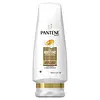What's inside
What's inside
 Key Ingredients
Key Ingredients

No key ingredients
 Benefits
Benefits

 Concerns
Concerns

 Ingredients Side-by-side
Ingredients Side-by-side

Water
Skin ConditioningCetyl Alcohol
EmollientStearamidopropyl Dimethylamine
EmulsifyingGlycerin
HumectantStearyl Alcohol
EmollientGlutamic Acid
HumectantBis-Aminopropyl Dimethicone
Sodium Chloride
MaskingPanthenol
Skin ConditioningPanthenyl Ethyl Ether
Histidine
HumectantParfum
MaskingDisodium EDTA
Citric Acid
BufferingPhenoxyethanol
PreservativeBenzyl Alcohol
PerfumingMethylchloroisothiazolinone
PreservativeMethylisothiazolinone
PreservativeWater, Cetyl Alcohol, Stearamidopropyl Dimethylamine, Glycerin, Stearyl Alcohol, Glutamic Acid, Bis-Aminopropyl Dimethicone, Sodium Chloride, Panthenol, Panthenyl Ethyl Ether, Histidine, Parfum, Disodium EDTA, Citric Acid, Phenoxyethanol, Benzyl Alcohol, Methylchloroisothiazolinone, Methylisothiazolinone
Aloe Barbadensis Leaf Juice
Skin ConditioningBehentrimonium Methosulfate
Cetearyl Alcohol
EmollientCarthamus Tinctorius Seed Oil
MaskingGlycerin
HumectantStearamidopropyl Dimethylamine
EmulsifyingPropanediol
SolventPanthenol
Skin ConditioningPolyquaternium-10
Nigella Sativa Seed Oil
EmollientTocopheryl Acetate
AntioxidantCitrus Nobilis Peel Oil
MaskingVanillin
MaskingLactic Acid
BufferingCaprylhydroxamic Acid
Anthemis Nobilis Flower Extract
MaskingAlthaea Officinalis Root Extract
Skin ConditioningGeranium Maculatum Oil
MaskingCamellia Sinensis Leaf Extract
AntimicrobialRosmarinus Officinalis Leaf Extract
AntimicrobialBrassica Oleracea Italica Seed Oil
EmollientUrtica Dioica Extract
AstringentSalvia Officinalis Extract
AntimicrobialPogostemon Cablin Leaf Oil
MaskingEquisetum Arvense Extract
AstringentCaryocar Brasiliense Fruit Oil
Skin ConditioningCitrus Aurantium Bergamia Fruit Oil
MaskingAnthemis Nobilis Flower Oil
MaskingCitrus Paradisi Seed Oil
PerfumingLavandula Angustifolia Oil
MaskingCitrus Aurantium Dulcis Seed Oil
MaskingCocos Nucifera Oil
MaskingBoswellia Carterii Oil
MaskingCaprylyl Glycol
EmollientAloe Barbadensis Leaf Juice, Behentrimonium Methosulfate, Cetearyl Alcohol, Carthamus Tinctorius Seed Oil, Glycerin, Stearamidopropyl Dimethylamine, Propanediol, Panthenol, Polyquaternium-10, Nigella Sativa Seed Oil, Tocopheryl Acetate, Citrus Nobilis Peel Oil, Vanillin, Lactic Acid, Caprylhydroxamic Acid, Anthemis Nobilis Flower Extract, Althaea Officinalis Root Extract, Geranium Maculatum Oil, Camellia Sinensis Leaf Extract, Rosmarinus Officinalis Leaf Extract, Brassica Oleracea Italica Seed Oil, Urtica Dioica Extract, Salvia Officinalis Extract, Pogostemon Cablin Leaf Oil, Equisetum Arvense Extract, Caryocar Brasiliense Fruit Oil, Citrus Aurantium Bergamia Fruit Oil, Anthemis Nobilis Flower Oil, Citrus Paradisi Seed Oil, Lavandula Angustifolia Oil, Citrus Aurantium Dulcis Seed Oil, Cocos Nucifera Oil, Boswellia Carterii Oil, Caprylyl Glycol
 Reviews
Reviews

Alternatives
Ingredients Explained
These ingredients are found in both products.
Ingredients higher up in an ingredient list are typically present in a larger amount.
Glycerin is already naturally found in your skin. It helps moisturize and protect your skin.
A study from 2016 found glycerin to be more effective as a humectant than AHAs and hyaluronic acid.
As a humectant, it helps the skin stay hydrated by pulling moisture to your skin. The low molecular weight of glycerin allows it to pull moisture into the deeper layers of your skin.
Hydrated skin improves your skin barrier; Your skin barrier helps protect against irritants and bacteria.
Glycerin has also been found to have antimicrobial and antiviral properties. Due to these properties, glycerin is often used in wound and burn treatments.
In cosmetics, glycerin is usually derived from plants such as soybean or palm. However, it can also be sourced from animals, such as tallow or animal fat.
This ingredient is organic, colorless, odorless, and non-toxic.
Glycerin is the name for this ingredient in American English. British English uses Glycerol/Glycerine.
Learn more about GlycerinPanthenol is a common ingredient that helps hydrate and soothe the skin. It is found naturally in our skin and hair.
There are two forms of panthenol: D and L.
D-panthenol is also known as dexpanthenol. Most cosmetics use dexpanthenol or a mixture of D and L-panthenol.
Panthenol is famous due to its ability to go deeper into the skin's layers. Using this ingredient has numerous pros (and no cons):
Like hyaluronic acid, panthenol is a humectant. Humectants are able to bind and hold large amounts of water to keep skin hydrated.
This ingredient works well for wound healing. It works by increasing tissue in the wound and helps close open wounds.
Once oxidized, panthenol converts to pantothenic acid. Panthothenic acid is found in all living cells.
This ingredient is also referred to as pro-vitamin B5.
Learn more about PanthenolWe don't have a description for Stearamidopropyl Dimethylamine yet.